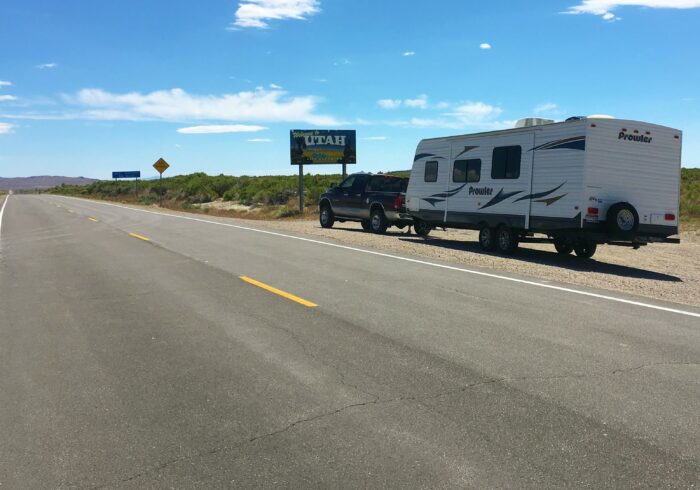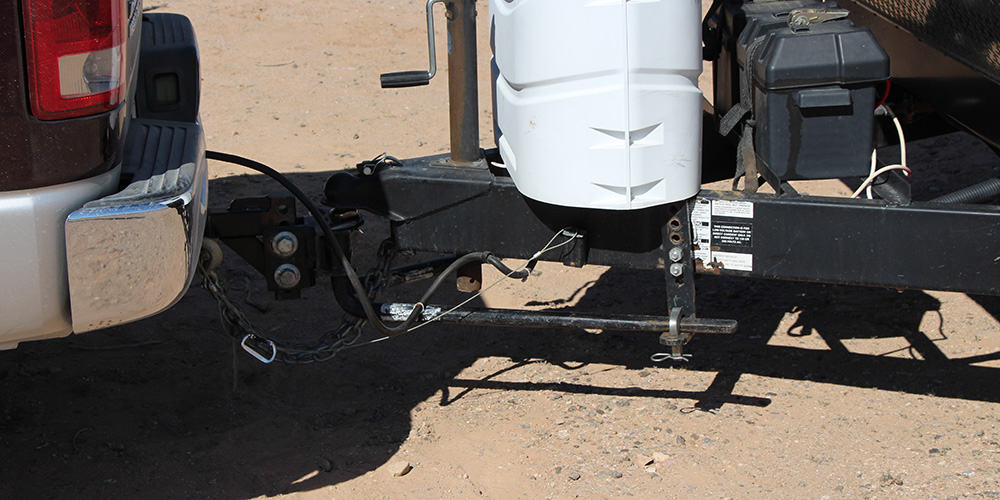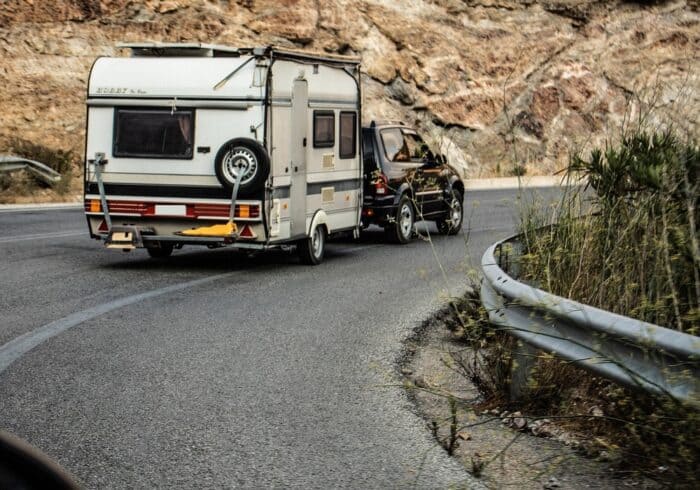What Do I Do When A Trailer Starts To Sway?
Trailer sway is when a trailer starts to rock from side to side uncontrollably.
It’s a scary feeling when it starts to happen. Your vehicle will also start to rock from the motion of the trailer. If it gets too bad it can cause you to lose control on the road.
Related Product: Use a TireMinder (click to view on Amazon) to wirelessly monitor the PSI in your trailers tires and be warned of flat tires.
Trailer sway can happen to anyone towing any kind of trailer. Cargo, utility, travel trailer, 5th-wheel, it doesn’t matter.
In this article, I’ll go over the 5 critical things you should do when trailer sway happens. Failure to do these may end up in increased trailer sway and you could be thrown off the road by your trailer.
See Also: Can Travel Trailer Tires Be Aligned? How To Check Alignment
Trailer Sway Procedure
- Take Your Foot Off The Gas – You need to slow down, but you need to do it gradually.
- DO NOT BRAKE – Braking will only make trailer sway worse and you could lose control of your vehicle and trailer.
- Keep The Steering Wheel Straight – You don’t want to turn in to or fight the trailer sway. This will only increase it.
- Gently Apply Trailer Brakes Manually – You can usually apply your trailer brakes manually with the brake controller. There’s normally a lever you can push below the steering. Gently apply the brakes on your trailer to slow it down. If your trailer does not have trailer brakes you may be able to straighten your trailer by increasing your speed slightly. Never increase your speed to try and stop trailer sway if you are going down a hill.
- Pull Over & Inspect – Trailer sway can happen for many reasons that I will outline below. Pulling over and inspecting your trailer to determine the cause of the sway and fixing it will hopefully stop it from happening again.
See Also: Difference Between Weight Distribution & Sway Control

What Causes Trailer Sway?
There are 5 main causes for trailer sway. Understanding each one and taking the necessary steps to fix problems before you start towing will help reduce the risk for trailer sway.
Excessive Speeds
Many people don’t know this but almost all trailers especially travel trailers are only rated to go 65 mph safely.
Some cargo trailers are rated to go even slower. You can find out the rated speed for your trailer through the manufacturer or possibly even the dealer.
Going faster than 65 mph or the max speed your trailer is rated for greatly increases the chances of trailer sway.
Wind Gusts
The wind is a huge cause of trailer sway. Sudden strong gusts of wind can hit your trailer from the side and cause it to start rocking from side to side.
If your trailer is already at high risk for trailer sway even a gust of wind from a passing semi-truck could send it into sway.
Slowing down when you see a semi-truck coming or even pulling over during high crosswinds are the best ways to reduce your risk for dangerous trailer sway caused by wind.
See Also: RV Truck & Trailer Towing Capacity – How Much Can I Tow?
Improper Weight Distribution
Having too much weight in the back and even the front of your travel trailer makes it more susceptible to trailer sway.
It’s better to have the heavy stuff over the axles of your trailer and towards the front. But the front should not be loaded so much that your tongue weight is more than 15% of the total trailer weight.
On that same note, the tongue weight should never be lower than 10% of the total trailer weight.
Also having more weight on one side of the trailer can cause it to steer itself towards that side and it will begin to sway on the road.
Weight distribution hitches are one of the best ways to help even out the weight on heavy trailers. I talk more about them and how they reduce trailer sway below.
Over Loaded Trailer
Every trailer has a max weight that it is rated for and not legal to go over. On a cargo trailer, it’s easy to look at the max trailer weight and load it accordingly but on a travel trailer, a lot of people don’ think about their holding tanks.
You can load up a travel trailer right to the max but when it’s time to fill up the fresh water tank you are going to end up even as much as 500 lbs over the weight limit.
See Also: Best 12V RV Air Compressor/Tire Inflator With Gauge
When loading your travel trailer with your stuff make sure you leave enough weight allowance for your freshwater tank to be full without going over the max weight limit.
If you often tow with the grey, black, and fresh water tank full make sure you calculate those weights as well.
The axels and the suspension system on your trailer are made for the max weight. A trailer that’s too heavy could damage the suspension and cause the trailer to start to sway.
Low Tire Pressure
A tire with low pressure will compress and decompress with the road’s bumps and turns.
The more movement the tires are allowed to have through low pressure the higher your chances are that the entire trailer will start to swing and bounce which will result in trailer sway.
Keeping the tires at the correct pressure on your tow vehicle and trailer will solve this problem.
Note that most trailer tires are meant to be inflated to the max psi. This is to keep the sidewalls stiff and working properly.
See Also: Best RV 5th-Wheel & Travel Trailer Tires Review/Buying Guide

Best Ways To Reduce The Risk For Trailer Sway
Now that you know what to do when your trailer starts to sway and the reasons trailer sway happens you probably are wondering how you can stop trailer sway before you get out on the road.
There are some great products out there made specifically for reducing trailer sway and help you stay safe on the road.
Weight Distribution & Sway Control Hitches
You are usually required to use a weight distribution hitch when your trailer is over a certain weight compared to your tow vehicle.
For instance, half-ton (1500) trucks are required by the manufacturer to use a weight distribution hitch when towing trailers over 5,000 lbs.
3/4 and 1-ton trucks are required to use one when towing over 6,000 lbs. You can find what the exact weight limit for your vehicle is from the manufacturer.
Most travel trailers are also required to be towed with a weight distribution hitch.
As another easy to follow rule of thumb is if the weight of the trailer is over 50% of the tow vehicle’s weight you should use a weight distribution hitch.
See Also: Best Weight Distribution Hitches With Sway Control
Usually, sway control is integrated into the design of a weight distribution hitch or there is a sway control bar included with the purchase of one.
If you don’t want to use a weight distribution hitch because your trailer is under the required weight, you can use a sway control bar to reduce trailer sway.
For more information on the difference between weight distribution and sway control check out this article here.
Stiffer Tow Vehicle Tires
Heavy-duty trucks that are made for towing have tires that are stiffer than regular passenger vehicle tires.
Many SUVs and half-ton trucks like the F-150 have the capabilities to tow but come with passenger tires.
Upgrading to light truck tires will give you better towing performance and decrease the risk for trailer sway.
Know Your Tongue Weight
I talked a little bit about the importance of having your trailer loaded so the tongue weight is between 10-15% (preferably 15%) of the total trailer weight but I’m going to emphasize it here.
Tongue weight is so important. Having the bulk of the weight of your trailer too much in the front causes your tow vehicle to “squat”. This will lift the front of your vehicle and make it harder to control.
See Also: How To Install An Electric Tongue Jack On A Trailer
Sway control is just one reason to make sure your trailer is loaded the correct way to keep your tongue weight correct.
To make sure you have the correct tongue weight on your trailer you can use a tongue scale like the Sherline LM 2000 (click to see on Amazon) to weigh the tongue of your trailer.
If you don’t know the total weight of your trailer when it’s loaded down you can use a trailer scale to find the final total weight. This is also a good way to make sure your trailer hasn’t gone over its maximum weight limit.
Public trailer scales can be found at some gas stations, feed stores, and possibly your local scrap metal yard. CAT has scales all over the United States and their locator tool is a great way to find a public trailer scale near you. (click here to go to CAT Scale Locator)

Final Thoughts About Avoiding Trailer Sway
Trailer sway is a very real and very dangerous threat that everyone towing a bumper pull trailer faces.
Unfortunately, there are people out there towing travel trailers or bumper pull cargo trailers who don’t know about trailer sway and its dangers until it’s too late.
Educating yourself and others on what to do when trailer sway happens and the best ways you can reduce the risk is important to not only keep you safe on the road but others as well.
See Also: Best Wireless RV Backup Cameras & Systems Reviewed
Accidents happen and even if you’ve done everything right trailer sway can still happen. Always be aware of what your trailer is doing behind you.
Trailer sway creates a risk for you and the people in vehicles driving around you.
If you find yourself being pulled around the road by a swaying trailer remember to follow the 5 steps calmly and do not slam on the brakes no matter what you do.
Have any questions about what to do when your trailer starts to sway and how to reduce the risk of trailer sway? Leave a comment below.


Great information to have safety trip with a trailer. Thanks so much!
Thank you, Natalie!
It’s great to know that it’s recommended to get a weight-distribution hitch with a sway control bar, so your cargo trailer to reduce trailer sway. My father is has been looking for a tilt equipment trailer for sale for his barn needs on the family ranch. I’ll share this information with him later so he can also buy the proper trailer accessories. Thanks a lot!
It’s also important to have an experienced trailer hitch installer properly set up the weight distribution hitch and the anti-sway bar. Those who choose to go the do-it-yourself route should carefully read the installation and operating instructions and seek advice from an experienced person. It’s easy to do it wrong.
Great advice, as someone that normally goes the diy route your comment makes me think twice about this one.
We had a hitch receiver installed on our vehicle and didn’t realize until after the fact that it is not rated to use with a weight distribution system. Can we still use a sway control bar with this type of receiver?
Hi Richard,
A sway control bar should be ok since it doesn’t add pressure to the hitch receiver. I would contact the manufacturer to check just in case.